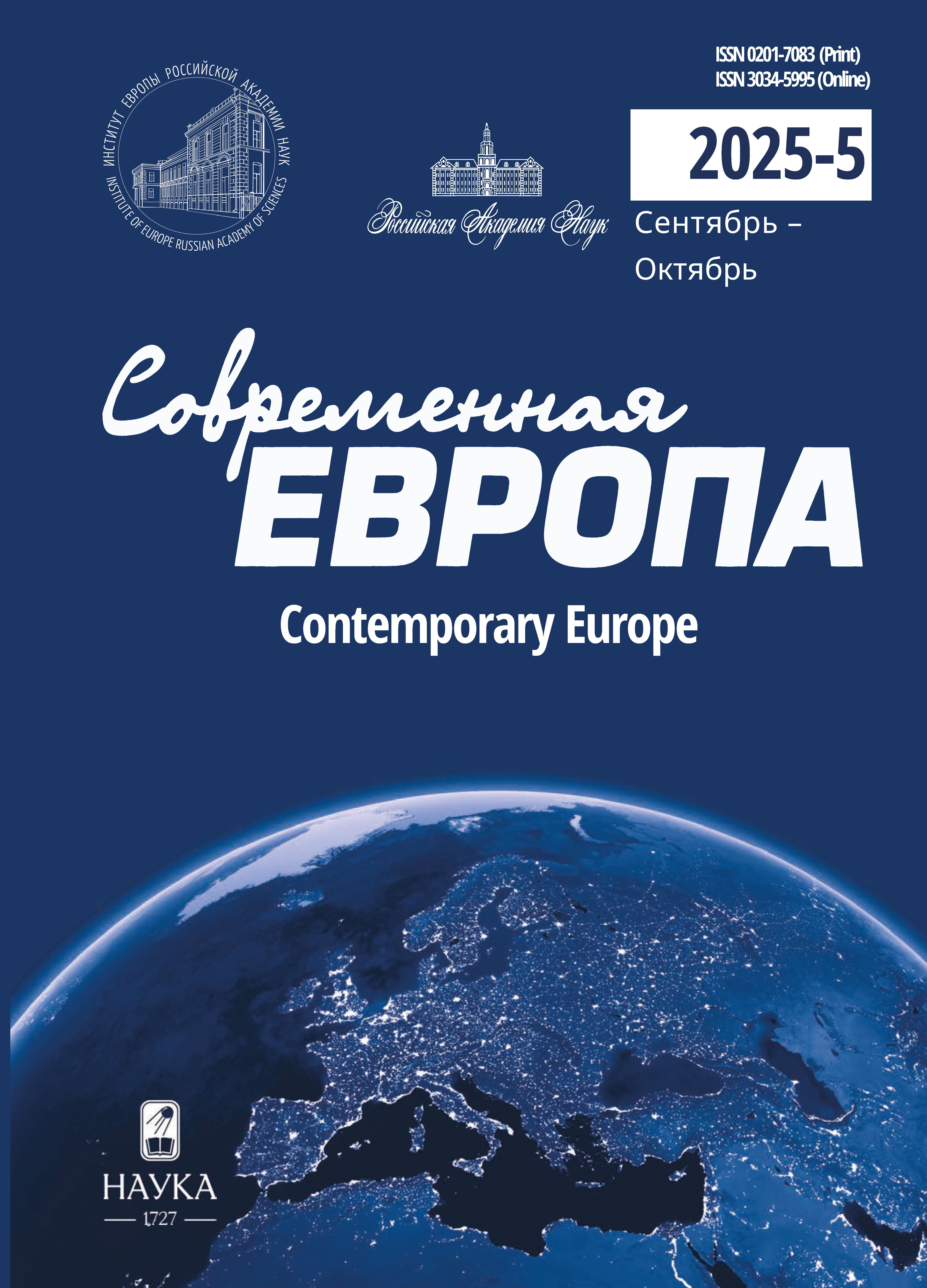Factors of Social Disintegration in EU
- Authors: Lunkin R.N1
-
Affiliations:
- Institute of Europe of the Russian Academy of Sciences
- Issue: No 5 (133) (2025)
- Pages: 142-156
- Section: SOCIAL SPHERE
- URL: https://cardiosomatics.ru/0201-7083/article/view/695693
- DOI: https://doi.org/10.31857/S0201708325050122
- ID: 695693
Cite item
Abstract
The article analyzes the factors of social disintegration in the EU through the prism of social divisions and the concept of a divided society. Based on the analysis of the specifics of the EU’s social dimension in general and the implementation of the Pillar of Social Rights, in particular, a number of interrelated factors have been identified, such as the growth of various forms of inequality, civic exclusion and social fragmentation. The situation of households, indicators related to poverty and social exclusion, youth out of employment and education, as well as the fragmentation of society and public sentiment in the context of falling incomes and a new technological transition are considered. It is concluded that the social crisis, firstly, has deep foundations that cannot be explained by such phenomena as population aging, uncontrolled immigration or deindustrialization. Secondly, the disintegration in the social sphere confirms the existence of a more diverse and stable social base of protest non-systemic parties and movements in the EU countries. The factors of inequality, civic exclusion, and social fragmentation have one important unifying element that explains the identitarian nature of alternative ideologies to neoliberalism that have become popular since the 2010s. As part of these phenomena, citizens face the decline in well-being, so as their deprivation which is closely linked to the threat of abandoning their former identity, along with a rethinking of the institution of family, work, and the lack of an understandable and predictable future in the AI economy, platform employment, and green technologies.
Keywords
About the authors
R. N Lunkin
Institute of Europe of the Russian Academy of Sciences
Email: romanlunkinn@yandex.ru
Doctor of Sciences (Politics), Professor of the Russian Academy of Sciences, Deputy Director Moscow, Russia
References
- Биссон Л.С., Лункин Р.Н. (2021) Контуры новых социально-политических кливажей в странах ЕС. Общественные науки и современность. № 6. С. 7–23. DOI: 10.31857/ S086904990017872-1
- Буторина, О. В., Борко Ю.А. (2022) Выгоды региональной интеграции: пересмотр концепции. Современная Европа. № 1(108). С. 5–20. doi: 10.31857/S0201708322010016. EDN FOZSGP.
- Гидденс Э. (2002) Социальная справедливость в программной дискуссии европейской социал-демократии. Социал-демократия сегодня. Вып. 1. Москва. С. 12–13.
- Говорова Н.В. (2024) Социальная экономика ЕС: путь к преодолению неравенства? Современная Европа. № 4. С. 140–150. doi: 10.31857/S0201708324040119
- Гоффе Н.В. (2024) Неравенство и бедность в цифровую эпоху. Современная Европа. № 6. С. 179–190. doi: 10.31857/S0201708324060160
- Европа в глобальной пересборке (2023) Отв. ред. Ал.А. Громыко. «Весь Мир», Институт Европы РАН, Москва. С. 192–206. doi: 10.15211/978-5-98163-209-9
- Европа в кризисном мире (2022) Под ред. А.А. Громыко, В.Б. Белов, Л.С. Биссон и др. «Весь Мир». Москва. 376 с. ISBN 978-5-7777-0895-3. doi: 10.55604/9785777708953. EDN PLQIBR.
- Липсет С., Роккан С. (2004) Структуры размежеваний, партийные системы и предпочтения избирателей. Предварительные замечания. Политическая наука. № 4. С. 204–234.
- Лункин Р.Н. (2023) Социальное неравенство в современном обществе риска. Современная Европа. № 7. С. 176–191. doi: 10.31857/S0201708323070148. EDN: rwwthd
- Семененко И.С., Лапкин В.В., Пантин В.И. (2021) Социальные размежевания и политические противостояния в научном дискурсе: критерии оценки и классификации. Полис. № 5. С. 56–77. https://doi.org/10.17976/jpps/2021.05.05
- Фадеева И.А. (2017) Дезинтеграционные процессы ЕС и будущее европейской интеграции. Международный журнал прикладных и фундаментальных исследований. № 5–1. С. 115–119. EDN YNWCCV.
- Antoniolli L., Bonatti L., Ruzza, C. (2019). Introduction: The Current Crisis of the European Union, Its Origins and Consequences. In: Antoniolli, L., Bonatti, L., Ruzza, C. (eds) Highs and Lows of European Integration. Springer, Cham. https://doi.org/10.1007/978-3-319-93626-0_1
- Liesbet Hooghe & Gary Marks (2018) Cleavage theory meets Europe’s crises: Lipset, Rokkan, and the transnational cleavage. Journal of European Public Policy. No. 25:1. P. 109–135, doi: 10.1080/13501763.2017.1310279
- Parijs Philippe Van. (2025) Chapter 1. Fighting for Social Europe when Europe is at war in: Sabato S., Ghailani D. and Spasova S. (eds) Social policy in the European Union: state of play 2024, Social Europe amidst the security and competitiveness paradigms, ETUI and OSE. P. 11–26.
- Sabato S., Ghailani D. and Spasova S. (2025) Social policy in the European Union: state of play 2024, Social Europe amidst the security and competitiveness paradigms, ETUI and OSE. P. 35–40.
- Scharpf Fritz W. (1997) Balancing positive and negative integration: The regulatory options for Europe. MPIfG working paper. No. 97/8.
- Scheiring G., King L (2023) Deindustrialization, social disintegration, and health: a neoclassical sociological approach. Theory and society. No. 52. P. 145–178. https://doi.org/10.1007/s11186-02209476-2
- Webber D. (2013). How likely is it that the European Union will disintegrate? A critical analysis of competing theoretical perspectives. European Journal of International Relations. No. 20(2). P. 341– 365. https://doi.org/10.1177/1354066112461286
- Wellings B. (2023). Nationalism and European disintegration. Nations and Nationalism. No. 29(4). P. 1164–1178. https://doi.org/10.1111/nana.12884
- Zeitlin J., Nicoli F., & Laffan B. (2019) Introduction: the European Union beyond the polycrisis? Integration and politicization in an age of shifting cleavages. Journal of European Public Policy. No. 26(7). P. 963–976. https://doi.org/10.1080/13501763.2019.1619803
Supplementary files











